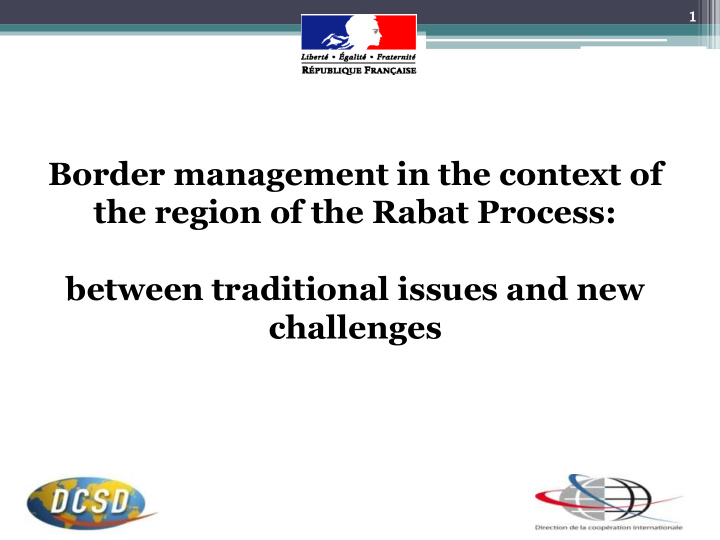



1 1 Border management in the context of the region of the Rabat Process: between traditional issues and new challenges
2 2 C R A S A C Regional Office for Civil Aviation Security
3 COMBATING LUTTE CONTRE AVIATION NETWORKS SURETE DE LES FILIERES SECURITY THAT ENTER L’AVIATION CIVILE UTILISANT LA VOIE AERIENNE BY AIR COMBATING LUTTE CONTRE IRREGULAR CONSEIL CONSULTING L’IMMIGRATION IMMIGRATION IRREGULIERE – AUDIT AUDIT – DOCUMENT FRAUDE EXPERTISE EXPERTISE DOCUMENTAIRE FRAUD Expertise of CRASAC
5 The challenges
6 6 Economic challenges
7 Economic migration - demographics - standard of living
8 World population, almost 10 billion habitants in 2050 PROJECTIONS IN MILLIONS n
9 Fertility rate * * Source : Perspectives économiques en Afrique
10 - High rate of unemployment -Large informal sector
11 International poverty threshold * Benin ----------------- 75.3 Burkina Faso -------- 72.6 Burundi -------------- 93.5 Cameroon -----------30.4 Cape Vert -------------40.6 Comores ------------65.0 Congo ----------------74.4 Côte d’Ivoire --------46.3 Gabon ----------------19.3 Guinea Conakry --- 69.6 Madagascar -------- 92.6 Mali --------------------78.7 Mauritania ----------- 47.7 Niger -----------------75.2 Nigeria ---------------84.5 CAR ------------------80.1 DRC ------------------95.2 Senegal -------------60.4 Chad ----------------83.3 Togo ------------------69.3 * Source : Perspectives économiques en Afrique
12 Migration policies Security challenges
13 It is important to recognise that pressures on borders were not anticipated and a dramatic increase in movement has taken place, having an impact on the security policies that were in place.
14 These issues derive from different sources Frozen or forgotten conflicts that are reignited (Mali) The overturn of older authoritarian regimes (Libya, Tunisia, Egypt) Power conflicts with capital hierarchy refusal – rural areas (Nigeria…) Acquisition of territories by criminal groups (Mali, Nigeria, ….)
15 15 15 Political challenges : between ethnic, sectarian and political violence
16 Unresolved conflicts: DRC Central African Republic
17 17 Terrorism
18 The main terrorist movements in Africa
19 19 Challenges specific to the region
20 20 Vast countries
21 21 Border posts that are isolated from central authorities
22 22 Border posts that are isolated from each other
23 23 Means of bribery by service and by trip The challenge of corruption
24 24 Communities and border management
25 There are therefore numerous challenges and others to be added are: high running and maintenance costs at borders, especially for mobile structures lack of coordination from national services lack of cross-border cooperation lack of qualified personnel States that are suspicious of each other
26 MALI
27 78,7% of the population below the international poverty threshold (43,6% NPL) Unemployment rate of 9,6 % Fertility rate of 6,2 Post colonial conflicts Crises in neighbouring countries
28 Migration policy and geographical situation
29 The Malian crisis : the consequences of migration
30 Efficient management methods
31 The methods used for effective border management are recognised as and derive from: collecting and passing on border data technology that meets the demands and suits the environment recruiting and training specialised personnel creating and implementing procedures in methods to combat fraud creating or multiplying checking methods developing internal and external strategic partnerships
32 Decisions have been made, primarily related to: creating border management strategies (Senegal, Gabon, Côte d’Ivoire, Mauritania) creating one-stop border posts (project WAEMU) creating joint teams in shared controlled areas exchanging information (regional, continental and international organisations) harmonising State legislations
33 The key trio - Control - Inform - Monitor
34 The solutions found can be referenced : 1 st factor : will and capability of States / institutional and legal framework 2 nd factor : infrastructures and equipments / need for resources 3 rd factor : human resources and training 4 th factor : communication / coordination / cooperation
35 1st factor Will and capability of States to control their own borders SOLUTION Decide on a usage policy and a communication policy Define simplified procedures, produce and circulate a table on monitoring movements, produce analyses of flows through an office specifically created for this Organise collecting and centralising data, develop utilities for file consultation and interconnect the systems Systematise criminal proceedings
36 2nd factor Need for resources (cooperation and complementarity) SOLUTION Build approved posts Equipment (furniture, office equipment, transmission, machinery etc…) Sufficient specialised human resources
37 3rd factor Need for specialised personnel and tailored training SOLUTION Provide training for trainers Provide training for personnel Design an annual training plan Tailor the initial training by integrating cross-specialist skills (document fraud etc…)
38 4th factor Need for coordination and complementarity SOLUTION Establish technical agreements between managements and Ministries Organise exchanges Organise joint controls Develop international exchanges (interpol borne I 24 7)
39 Thank you for your attention
40 dci-crasac@orange.sn philippe.duporge@diplomatie.gouv.fr Ambassade de France 1 rue El Hadji Amadou Assane NDOYE BP 4035 DAKAR 00221 33 839 51 95 00221 77 461 56 46
Recommend
More recommend